新能源汽车专业英语4-1
- 格式:ppt
- 大小:1.41 MB
- 文档页数:40
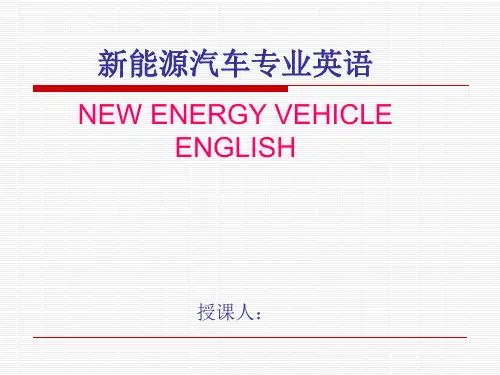
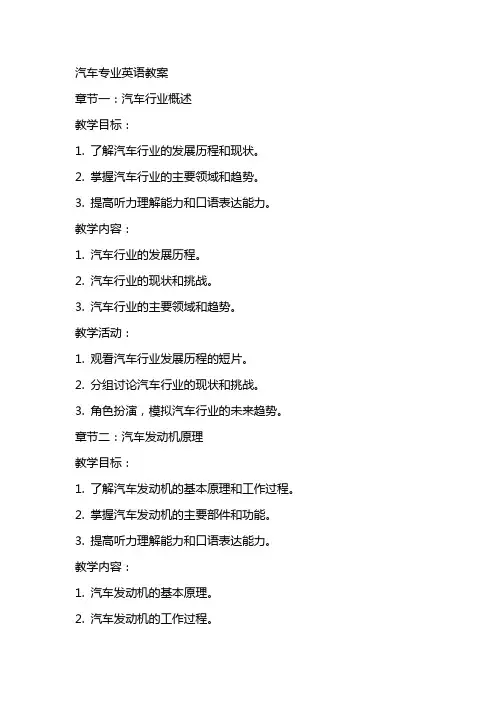
汽车专业英语教案章节一:汽车行业概述教学目标:1. 了解汽车行业的发展历程和现状。
2. 掌握汽车行业的主要领域和趋势。
3. 提高听力理解能力和口语表达能力。
教学内容:1. 汽车行业的发展历程。
2. 汽车行业的现状和挑战。
3. 汽车行业的主要领域和趋势。
教学活动:1. 观看汽车行业发展历程的短片。
2. 分组讨论汽车行业的现状和挑战。
3. 角色扮演,模拟汽车行业的未来趋势。
章节二:汽车发动机原理教学目标:1. 了解汽车发动机的基本原理和工作过程。
2. 掌握汽车发动机的主要部件和功能。
3. 提高听力理解能力和口语表达能力。
教学内容:1. 汽车发动机的基本原理。
2. 汽车发动机的工作过程。
3. 汽车发动机的主要部件和功能。
教学活动:1. 观看汽车发动机工作原理的演示。
2. 分析汽车发动机的主要部件和功能。
3. 小组讨论,总结汽车发动机的工作过程。
章节三:汽车电气系统教学目标:1. 了解汽车电气系统的基本原理和组成。
2. 掌握汽车电气系统的主要部件和功能。
3. 提高听力理解能力和口语表达能力。
教学内容:1. 汽车电气系统的基本原理。
2. 汽车电气系统的组成和主要部件。
3. 汽车电气系统的工作过程和功能。
教学活动:1. 观看汽车电气系统工作原理的演示。
2. 分析汽车电气系统的主要部件和功能。
3. 小组讨论,总结汽车电气系统的工作过程。
章节四:汽车transmission 系统教学目标:1. 了解汽车transmission 系统的基本原理和类型。
2. 掌握汽车transmission 系统的主要部件和功能。
3. 提高听力理解能力和口语表达能力。
教学内容:1. 汽车transmission 系统的基本原理。
2. 汽车transmission 系统的类型和特点。
3. 汽车transmission 系统的主要部件和功能。
教学活动:1. 观看汽车transmission 系统工作原理的演示。
2. 分析汽车transmission 系统的主要部件和功能。
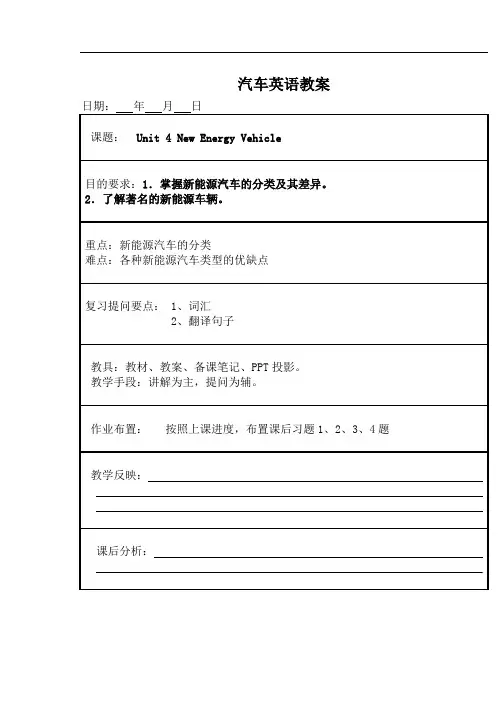
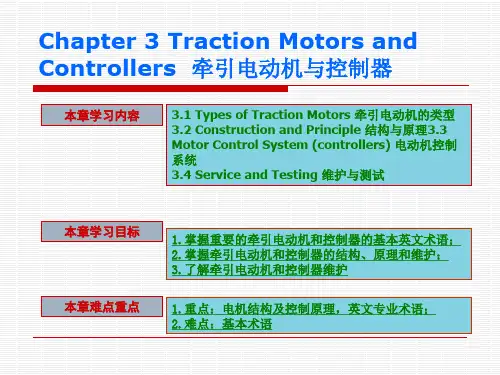
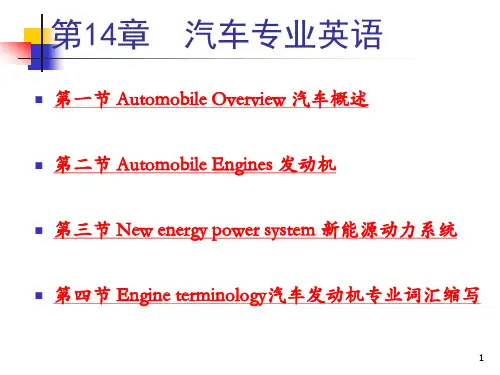
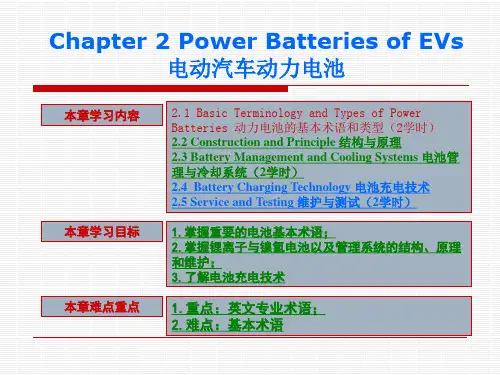
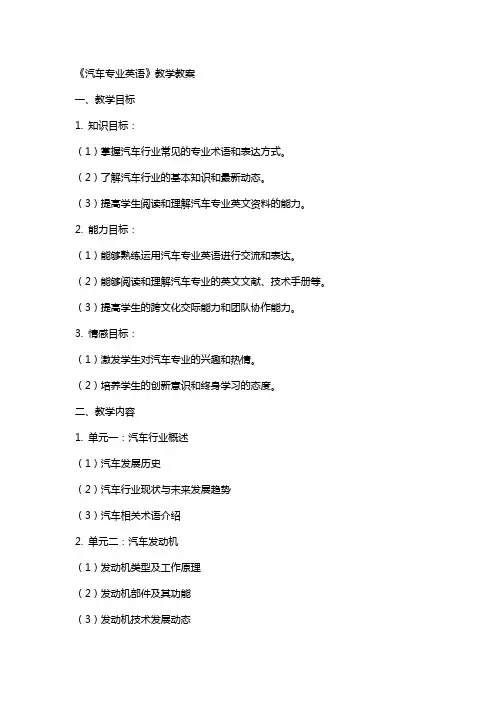
《汽车专业英语》教学教案一、教学目标1. 知识目标:(1)掌握汽车行业常见的专业术语和表达方式。
(2)了解汽车行业的基本知识和最新动态。
(3)提高学生阅读和理解汽车专业英文资料的能力。
2. 能力目标:(1)能够熟练运用汽车专业英语进行交流和表达。
(2)能够阅读和理解汽车专业的英文文献、技术手册等。
(3)提高学生的跨文化交际能力和团队协作能力。
3. 情感目标:(1)激发学生对汽车专业的兴趣和热情。
(2)培养学生的创新意识和终身学习的态度。
二、教学内容1. 单元一:汽车行业概述(1)汽车发展历史(2)汽车行业现状与未来发展趋势(3)汽车相关术语介绍2. 单元二:汽车发动机(1)发动机类型及工作原理(2)发动机部件及其功能(3)发动机技术发展动态3. 单元三:汽车电器与电子技术(1)汽车电器系统概述(2)汽车电子控制系统(3)新能源汽车电器与电子技术4. 单元四:汽车制动系统(1)制动系统类型及工作原理(2)制动器结构与性能(3)制动系统故障诊断与维修5. 单元五:汽车body and pnt(1)车身结构与材料(2)汽车涂装技术(3)车身修复与涂装工艺三、教学方法1. 讲授法:讲解汽车专业英语的基本知识和术语,阐述重点难点。
2. 案例分析法:分析具体汽车案例,培养学生解决实际问题的能力。
3. 小组讨论法:分组讨论,提高学生的团队协作能力和跨文化交际能力。
4. 情景模拟法:模拟汽车行业工作场景,进行角色扮演,提高学生的实际操作能力。
四、教学评价1. 平时成绩:课堂参与度、作业完成情况、小组讨论表现等。
2. 期中测试:汽车专业英语知识测试,检验学生学习效果。
4. 综合评价:结合学生课堂表现、测试成绩和论文质量,进行全面评价。
五、教学资源1. 教材:《汽车专业英语》教材及相关辅助材料。
2. 多媒体教学设备:投影仪、计算机、网络等。
3. 实践教学基地:汽车实验室、维修车间等。
4. 参考文献:汽车专业英文文献、技术手册、期刊杂志等。
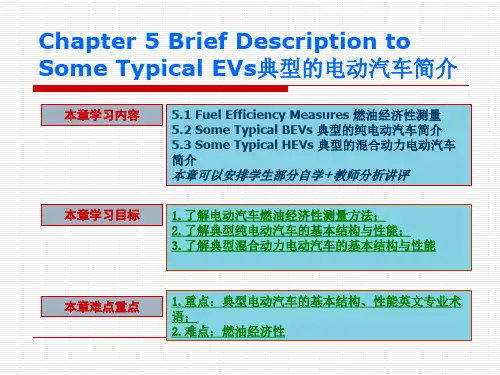
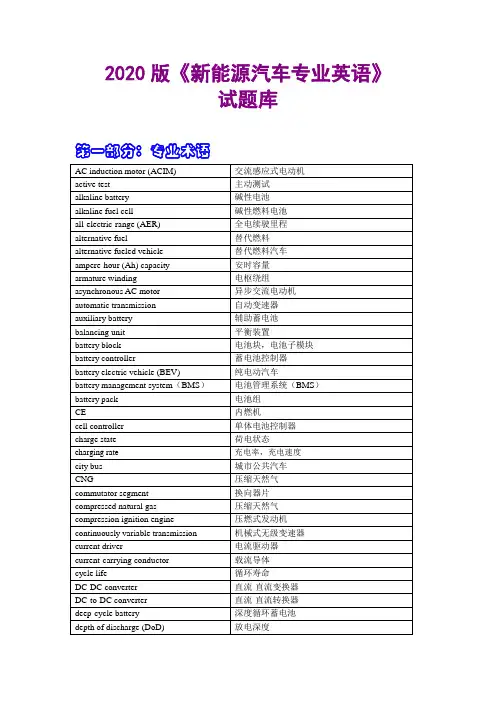
2020版《新能源汽车专业英语》试题库第一部分:专业术语第二部分:常用缩写第三部分:英译汉1. What are Alternative fuels currently commercially available and closely attended? 目前商业可用和受到密切关注的替代燃料有哪些?· Liquefied petroleum gas 液化石油气· CNG 压缩天然气· Methanol 甲醇· Hydrogen 氢· Fuel-cell 燃料电池· Electricity 电能· Hybrid(electricity + conventional fuels)混合动力(电+传统燃料)2. What are the types of electric vehicles? 电动汽车分为哪几种?Electric vehicles are broadly categorized into four groups based on the electric design of their powertrains, namely battery electric vehicles (BEVs), plug-in hybrid electric vehicles (PHEVs), hybrid electric vehicles (HEVs), and fuel-cell electric vehicles (FCEVs). Only BEVs and PHEVs are plug-capable, and are referred to as plug-in electric vehicles (PEVs).根据电动汽车动力传动系统的电动设计,将电动汽车大致分为四大类,即纯电动汽车(BEV)、插电式混合动力汽车(PHEV)、混合动力电动汽车(HEV)和燃料电池电动汽车(FCEV)。
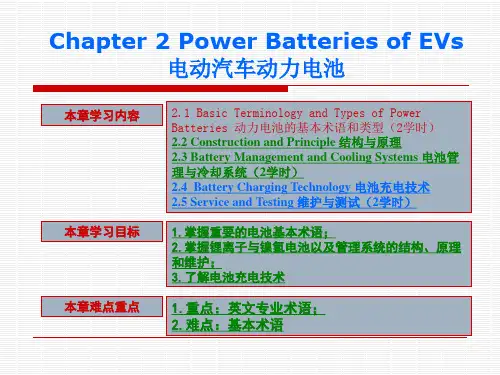
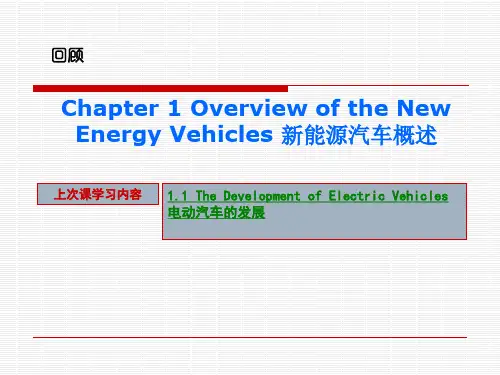
新能源汽车专业英语新能源汽车专业英语一、概述New energy vehicles (NEVs) are a type of vehicle that uses alternative energy sources, such as electricity, hydrogen fuel cells, or hybrid systems. They are becoming increasingly popular due to their environmental benefits and potential cost savings.二、电动汽车Electric vehicles (EVs) use electric motors powered by rechargeable batteries. They emit no tailpipe pollutants and have lower operating costs than traditional gasoline-powered cars. Types of EVs include battery electric vehicles (BEVs), plug-in hybrid electric vehicles (PHEVs), and hybrid electric vehicles (HEVs).三、燃料电池汽车Fuel cell vehicles (FCVs) use hydrogen gas to power an electric motor. The only emissions from FCVs are water vapor and heat. However, the infrastructure for producing and distributing hydrogen is still limited.四、混合动力汽车Hybrid electric vehicles combine an internal combustion engine with an electric motor to improve fuel efficiency and reduce emissions. There are two types of HEVs: series hybrids, where the engine charges the battery which powers the motor; parallel hybrids, where both the engine and motor can drive the wheels.五、充电基础设施Charging infrastructure is essential for EVs to be practical for daily use. This includes public charging stations at parking lots, shopping centers, etc., as well as home charging units installed in garages or driveways.六、政策支持和市场前景Many governments around the world offer incentives such as tax credits orrebates for purchasing NEVs in order to promote their adoption. The market outlook for NEVs is positive due to increasing concerns about climate change and air pollution, as well as advancements in technology making them more affordable and practical for consumers.七、未来发展趋势The future development trend of NEV industry will focus on improving battery technology to increase range while reducing costs; expanding charging infrastructure; developing new materials that can make lighter weight cars with longer ranges; exploring new business models such as car sharing services using NEV fleets; integrating smart technologies into NEV systems like autonomous driving features etc..。
新能源汽车好处英语作文英文回答:New energy vehicles, also known as electric vehicles, have become increasingly popular in recent years. There are several benefits of using new energy vehicles, both for individuals and for the environment.Firstly, new energy vehicles are more environmentally friendly compared to traditional gasoline-powered cars. They produce zero tailpipe emissions, which means they do not release harmful pollutants into the air. This helps to reduce air pollution and improve air quality, especially in heavily populated cities. For example, in Beijing, whereair pollution is a major concern, the government has been promoting the use of new energy vehicles to combat the issue.Secondly, new energy vehicles can help to reduce our dependence on fossil fuels. As we all know, fossil fuelsare limited and non-renewable resources. By using newenergy vehicles, we can decrease our reliance on oil and other fossil fuels, which will in turn help to conserve these valuable resources for future generations. Additionally, it can also help to stabilize fuel prices and reduce the vulnerability of our economy to fluctuations in oil prices.Furthermore, new energy vehicles are generally quieter and smoother to drive compared to traditional cars.Electric motors are known for their instant torque, which provides quick acceleration and a smooth driving experience. This can greatly enhance the comfort and enjoyment of driving, making it a more pleasant experience for thedriver and passengers.In addition to these benefits, new energy vehicles also have the potential to create new job opportunities and stimulate economic growth. The development and productionof electric vehicles require a different set of skills and expertise compared to traditional automobile manufacturing. This means that new industries and job positions can becreated, contributing to the growth of the economy. For example, the electric vehicle market has led to the emergence of new companies specializing in battery technology and charging infrastructure.To sum up, new energy vehicles have numerous advantages. They are environmentally friendly, reduce our dependence on fossil fuels, provide a smoother and quieter driving experience, and have the potential to stimulate economic growth. As more and more people recognize these benefits, the adoption of new energy vehicles is expected to continue to rise in the coming years.中文回答:新能源汽车,也被称为电动汽车,在近年来越来越受到欢迎。